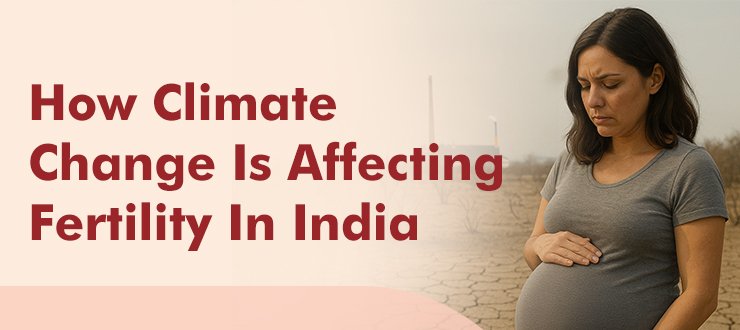
Being in India, climate change is a most profound challenge and a concern for every individual at a global level in the 21st century. The effects of climate change are not hidden as it has become more evident not just in the case of rising sea levels and extreme weather events but also in more subtle and personal areas such as human fertility. In India, a country already grappling with complex healthcare, environmental, and socioeconomic issues, climate change is emerging as a silent disruptor of reproductive health and fertility. Thus, it has become quite significant to understand the link between the climate and fertility as it largely affects health outcomes. In this article, we will understand how climate change is affecting fertility in India-
Fertility, whether it is related to men or women, is influenced or affected by a number of factors involving lifestyle, genetics, environment and many more. The dynamics of climate have introduced numerous environmental stressors that have impacted the reproductive system of humans on a huge level. This includes-
The changes in climate introduce various environmental stressors which have a huge impact on the reproductive system of humans, including-
The above factors collectively hamper or impair the functioning and balance of hormones while reducing the quality of sperm, disrupting the menstrual cycles, and increasing the risk of miscarriage. This also leads to adverse birth outcomes and affects the birth rate.
Climate change in India is frequent and dynamic, and India is particularly vulnerable to climate change:
As per the report of the Climate Risk Index 2021 by Germanwatch, India stands at the 7th rank among countries that have been affected mostly by extreme weather events between 2000 and 2019.
The average temperature in India has increased by approximately 0.7°C between 1901 and 2018, with projections of a 2.4–4.4°C rise by the end of the century, according to the Ministry of Earth Sciences.
India’s total fertility rate (TFR) has already declined from 2.2 in 2015–16 to 2.0 in 2019–21 (NFHS-5), reaching replacement level, but the effects of climate stress threaten to push it lower in vulnerable areas.
As per the study, the ideal scrotal temperature for sperm production is about 2–3°C below body temperature.
Moreover, exposure to temperatures above 35°C can impair spermatogenesis.
A study published in Nature Climate Change (2021) found that male fertility issues are high in India due to heatwaves, which diminished birth rates in India by up to 4.5%.
In a region like Central India, where heatwaves have become 10 times more frequent since 1950, this raises serious concerns. Moreover, this is increasing rapidly every summer till the year 2025 as seen. In cities like Nagpur or Delhi, temperatures now often exceed 45°C during peak summer.
The increase in temperature affects the development of ovarian follicles, which leads to disruption or missed ovulation cycles. Moreover, as per the study of The Lancet Planetary Health (2020) suggested that prolonged heat exposure may reduce the likelihood of conception in women by 10–20%, especially in rural areas without air conditioning or cooling systems.
Climate change and industrialization also increase exposure to endocrine-disrupting chemicals (EDCs)—such as phthalates, dioxins, and BPA, which mimic hormones and interfere with reproductive function.
Climate-induced disasters—such as floods, droughts, and crop failure—lead to chronic stress, displacement, and financial insecurity, all of which can lower libido and interfere with reproductive hormone production (LH, FSH, estrogen, testosterone).
A study in southern Odisha and Bihar (2021) showed:
Climate change is not just a global environmental issue—it is deeply personal, affecting the most intimate aspects of human life, including fertility. In India, with its massive population and extreme climate vulnerability, the intersection of environmental stress and reproductive health is becoming more pronounced.
Ignoring this connection could silently erode the nation’s reproductive capacity, especially among the poor and marginalized. Addressing it with evidence-based policy, healthcare reform, and environmental protection is not just essential—it’s urgent.